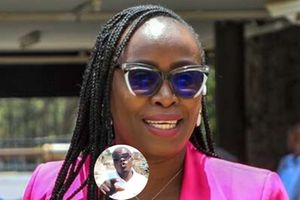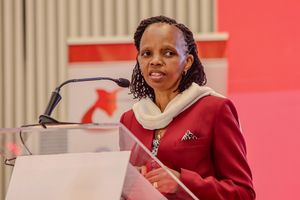The early battles between editors and publicity-hungry politicians

Jack Opiyo Gor displays old copies of Taifa Leo and the Nation newspapers. Inset: Tom Mboya and Jaramogi Oginga Odinga. Photos/DENNIS OKEYO
What you need to know:
- The final part of our serialisation of author GERRY LOUGHRAN’S book on the Nation, explores conflicts between the paper’s editors and politicians over favourable coverage
Simply, John Bierman, by nature a radical, and many of his bright young imports found so much that they abhorred in Kenyan society, from the institutional racism to the unfeeling complacency of many individual whites.
It was Bierman’s anger at the authoritarian stance of the colonial government that informed the photo story of Kenyatta at Lodwar. He published the pictures to give the lie to administration-fuelled rumours that Kenyatta was drinking heavily, and to raise a finger to the authorities who had refused to let reporters visit the old man.
Bierman, strictly speaking, was managing editor, while Curtis assumed the role, though never the title, of editor-in-chief.
“Michael allowed me enormous latitude (sometimes I think too much given how brash and pugnacious I was in those days) in setting day-to-day policy and writing leaders and running campaigns such as the one against the Press law,” Bierman recalled, “but every time I stuck our collective neck out, he backed me to the hilt, as did the Aga Khan.”
No legal right
The irascible Jones was another who sniped constantly at authority, particularly the police force of which he had once been a member. One column said: “The other day a policeman told a Nation photographer that he was not to take a particular picture and that if he did, the camera would be confiscated. I take pleasure in informing all members of the police that they have no legal right to take such action. A photographer can be rightfully arrested for obstructing a police officer or refusing to obey a lawful order but that gives the policeman no right to interfere with the contents of a camera. This assertion is made as a result of legal advice.”
Within three years, the Nation seemed to have established a firm reputation for iconoclasm.
In 1963, with independence fast approaching, waggish students hung a sign outside Government House: “This desirable residence for sale, owner going overseas very shortly.” The board was taken down and put in the office of the governor’s private secretary. A visitor to this functionary advised, “I should turn it to the wall or those Nation people will see it and plaster it all over their front page.”
Where hindsight shows the Nation got it wrong in the early days was in the largely Eurocentric nature of its perceptions. In the view of director Peter Hengel, “The paper was almost, in a sense, imitating the Standard and addressing their buyers.”
It seemed to speak to a white audience rather than an African or even a multiracial one, and while its coverage of Kenyan politics was sharp and comprehensive, the choice of many other stories was often made through a British lens. There seemed to be an obsession with Princess Margaret, newly engaged to society photographer Tony Armstrong-Jones.
The first issue of the Nation showed them at a theatre in London and so did the second. There followed stories on her wedding dress, the wedding in Westminster Abbey and finally an oleaginous caption to a honeymoon picture: “Hair tousled by the soft Caribbean winds, skin goldentanned from long days in the sun, Princess Margaret drives in an open car through the island of Dominica with her husband.”
The American statesman, Adlai Stevenson, once memorably observed: “An editor is one who separates the wheat from the chaff and prints the chaff.” The problem of course was that one man’s wheat was another man’s chaff.
Foreign reporting by the Western news services also reflected developed-world preoccupations, and it was only when Hilary Ng’weno took over the editorship in February of 1964 that an African relevance was properly addressed.
Sub-editors remember the Nation’s first African editor exploding wrathfully over wire-service coverage of the horrors in the Congo: “Africans are dying in droves and all we get are heroic paras rescuing beleaguered Belgians!”
The enthusiasm of the Press corps was dampened, however, when three photo-journalists working out of Nairobi – an African, an Asian and a European – ventured into the Congo and never returned.
Foreign news was something of an idée fixe with the Aga Khan. He believed African readers were interested in the world beyond Kenya, indeed beyond Africa, and when a research team investigated the market in 1963, that is precisely what it found.
It was probably expecting too much for white British journalists of the time to see through African eyes, but the problem of copy-tasting, deciding just what really interested the Kenyan reader, was to persist until the late 1970s, when there were finally enough trained African sub-editors to supplant their expatriate colleagues.
Revolutionary stuff
Bierman recalled Kenyatta telephoning: “You are causing splits, Mr Bierman” – because we would report on differences within Kanu.” When Mboya, too, protested, Bierman said: “Do you not realise we are on the African’s side, that we want basically what you want for this country?”
Said Mboya: “John, if I didn’t believe that, I wouldn’t bother to talk to you.”
Odinga’s approach was simpler. “He was invited to China to make a speech”, Bierman remembered. “The Americans monitored it and slipped me a transcript and it was pretty hot revolutionary stuff. After we printed it, he said to me over the phone: ‘Oh Mr Bierman, we will settle with you after uhuru”.’
The pressures worsened when independence neared under a Kanu administration. Mboya, the minister of Justice and Constitutional Affairs, ordered the burning of the Sunday Nation and the Mombasa Times, in the Nation’s case apparently because it gave greater prominence to his own remarks than to Kenyatta’s when Kenya’s first Prime Minister made a triumphal visit to Mombasa.
Mboya declared that if newspapers thought freedom of speech meant licence to write destructively about the country, then independent Kenya would have to do without any newspapers at all. At one point, the Standard remarked mildly that “Kadu seems to know where it’s going”.
Mboya shot back: “The Press must be aware … freedom does not mean irresponsibility.” Information minister Achieng’ Oneko, who was to prove the hammer of the media, warned that “any attempt to provoke disunity, to slight our Prime Minister or other members of the government in any way will not be tolerated by the government”.
Curtis suggested that an Editorial Advisory Board with in-house and outside members could form a useful line of defence. At first, the idea was confined to Taifa Leo and the outsiders suggested included Mareka Gecaga, Kenyatta’s friend Peter Mbiu Koinange, an up-and-coming politician named Mwai Kibaki, as well as John Seroney and Moody Awori.
Such a board was eventually established, responsible for all of the Group’s titles. Putting its bona fides on the line, the Nation also in later years drew up a Code of Ethics for its journalists, and published a statement of editorial policy and a list of editorial objectives which were approved by shareholders. The clear intention was to make the board of directors responsible for ensuring the guidelines were followed as part of corporate policy and protected from editorial whim or negligence – the only way quality control could be assured.
Since the board was not wholly Kenyan by membership or residence, however, there was need for an oversight body to monitor the papers’ independence, balance and quality.
God’s own country
What dominated life in Kenya at the time of the Nation’s gestation was the issue of independence, an event some whites secretly believed, and certainly hoped, would never come to pass. They had reason to think so. In 1950, Britain’s then Secretary of State for the Colonies, James Griffiths, said after a visit to Kenya: “This is God’s own country with the Devil’s own problems.”
Two years later, another colonial secretary, the anti-colonialist Arthur Creech Jones, was asked by a Labour party colleague, Denis Healey, about the prospects of majority rule. He replied, “Denis, Kenya will not be independent in my lifetime or yours.” As late as January 1959, the then Colonial Secretary Alan Lennox-Boyd hosted a conference of the three East African governors at which it was decided that Tanganyika might achieve independence by 1970, Uganda soon after and Kenya by 1975.
Thus when the colony’s delegates returned home from the January 1960 constitutional conference in London with a firm promise of independence, the sense of shock among Kenya’s whites was palpable. Even the African leaders were astounded. A.R. Kapila, the Kenyan lawyer who defended Kenyatta at his Kapenguria trial for managing Mau Mau, remembered meeting Tom Mboya when the delegation returned: “He was jumping up and down and shouting, ‘They’ve given in, they’re giving up’. He couldn’t believe it. It was like a man asking for a pound and being told, take five.”
In Nairobi, Bierman saw it in less elevated terms: “The British no longer had the political will or the economic wherewithal to hold down an empire, so the best thing was to get out in good order and as decently as possible.”
Birth of a Nation is published by I.B. Tauris, 6 Salem Road, London W2 4BU, and is available for purchase online and from leading bookstors. Copyright (C) Gerry Loughran, 2010




